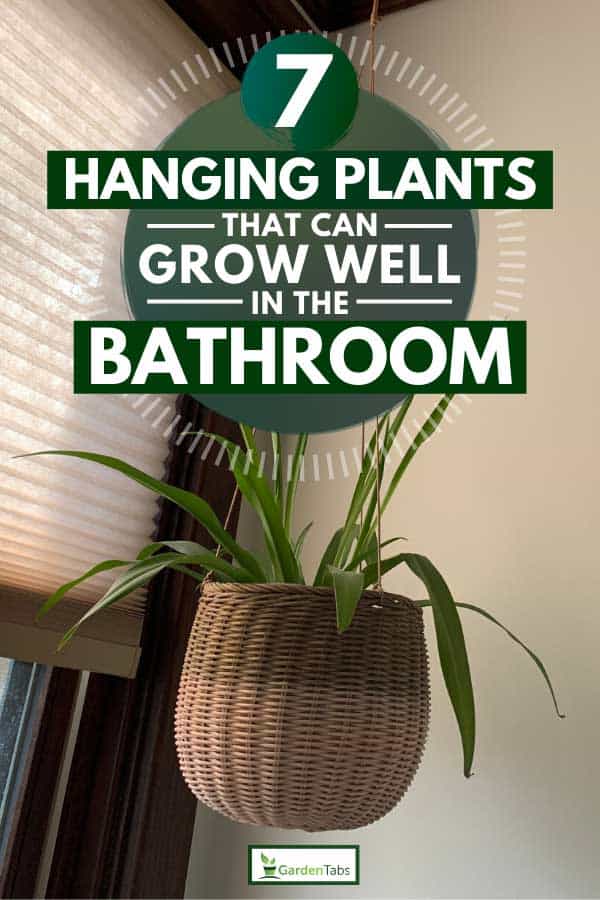Houseplants revitalize any room in your home by not only boosting your mood but improving the air quality in the vicinity. Plus, you can add vibrant colors and rich textures to any room by coordinating plant foliage and blooms with your home’s decor.
If you want another excellent location for houseplants, why not try hanging a plant in the bathroom? Many types of houseplants thrive in the bathroom’s warm, humid climate. Typically vine-like, hanging houseplants are voracious growers that can transform your bathroom into a private oasis.
Check out our list of hanging plants for the bathroom to find a plant that coordinates with your style. All of these low-maintenance plants are great for indoors because they prefer indirect to low-lighting conditions.
1. Spider Plant
The spider plant (chlorophytum comosum), a South African native, makes a colorful addition to the bathroom with its variegated, white, and green striped leaves. Slender, overarching foliage springs forth offshoots or pups to produce new plants. Dangling pups resemble baby spiders as if ballooning away from the nest. Occasionally, the spider plant will also produce tiny, white flowers.
The humid bathroom is ideal for spider plants because they prefer a warm climate (55°F - 80°F) and permeable, evenly moist soil. Provide bright, indirect sunlight for a happy spider plant.
2. Pothos
The luscious pothos (epipremnum aureum) or Devil’s ivy will lure your attention with its heart-shaped, variegated leaves. Different varieties display predominantly yellow (golden pothos), white (marble pothos), or green (jade pothos) flecks of color. Pothos is slow-growing but creeps along to reach between six and 10-feet long.
Naturally thriving beneath the canopy of Solomon Island rainforests, pothos will feel at home in a bathroom climate. It prefers warm temperatures (70°F - 90°F) and permeable, moist soil. Pathos is a shade dweller, so moderate to low lighting conditions are sufficient.
Note that pathos is a toxic plant. Sap can cause skin irritation, and ingesting either the stem or leaves can cause vomiting. It is rarely fatal, but pathos should be kept out of reach of children and pets.
https://www.instagram.com/p/B_an2vXHEQ1/?igshid=1nya30noh1ibp
3. Sword Fern
North American native sword fern (polystichum munitum) is a woodsy plant that transitions beautifully to be grown indoors. Robust, sword-shaped fronds overflow hanging pots for a bushy, lush appeal. Vibrant shades of lighter and darker greens brighten any home.
Because sword ferns naturally thrive on forest floors, they are an excellent choice to locate in the bathroom. Sword ferns prefer moderate temperatures (50°F - 70°F), and moist soil of any type. Happy in the shade, moderate to low lighting conditions are adequate for sword ferns.
4. Asparagus Fern
Also called lace fern, bride’s bouquet fern, and climbing asparagus, the asparagus fern (asparagus setaceus) is not actually a fern. It is a herbaceous, evergreen vine. Feathery, fern-like foliage adorns wiry stems that can climb up to 3-feet. Minuscule, white flowers are displayed annually, followed by green berries that blacken as they mature. As a hanging plant, the asparagus fern has a bushy appearance.
Asparagus ferns prefer humid climates, so the bathroom location is ideal. Warm temperatures (60°F - 72°F) and permeable, moist soil keep asparagus ferns happy. Bright, indirect sunlight is the best lighting condition for asparagus ferns.
5. Begonia
With over 1,600 species of begonia within the begoniaceae family, it can be daunting to select the perfect plant for your home. To get to the root of it, begonia varieties with either fibrous roots or a rhizome generally thrive indoors.
Colors are dynamic for either flowering or foliage varieties of begonias. Flowering begonias exhibit white, yellow, salmon, red, or pink blooms. Foliage begonias display variegated leaves in shades of red, purple, grey, silver, or green. Leaf shape can vary to include heart-shaped, star-shaped, oval, and wing-shaped.
Begonias prefer warm (62°F - 72°F), humid climates such as that in your bathroom. Keep soil moist, drying only slightly between waterings. Provide bright, indirect sunlight for optimal flowering. Foliage varieties sometimes prefer low-light conditions, but check your growing instructions to be sure.
6. Philodendron
The sweetheart plant, philodendron, is a tropical native to South America. It displays glossy, dark green, or reddish-bronze foliage. Robust, heart-shaped leaves (p. headeraceum) commonly adorn vine and non-climbing varieties, but you can also select arrow-shaped (p. erubesens) or forked (p. bipinnatifidum) leaf types. Vine varieties, growing upwards of 4-feet, are popular hanging plants that can either dangle or be trained to climb.
A humid bathroom climate is ideal for philodendron. It prefers warm temperatures (65°F - 78°F) and permeable, moist soil. Bright, indirect sunlight produces lush foliage, but philodendron will also tolerate low-light conditions.
7. English Ivy
Hedera helix or English ivy is native to northern and central Europe. Woody vines of English ivy cascade beautifully from a hanging pot to exhibit heart-shaped, dark green, or variegated whiteish-green leaves.
Although it is not a tropical plant, English ivy prefers high humidity and moderate temperatures (65°F - 78°F). Keep the soil moist, but err on the drier side between waterings. English ivy does best in bright to moderate, indirect lighting conditions.
Now that you know about different types of hanging plants for your bathroom, get inspired with more houseplant ideas by visiting our other blogs:
